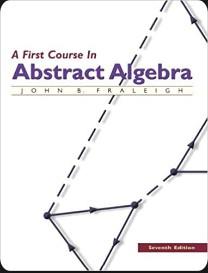Corollary 27.18 tells us that every ring with unity contains a subring isomorphic to either Z or
Question:
Corollary 27.18 tells us that every ring with unity contains a subring isomorphic to either Z or some Zn. Is it possible that a ring with unity may simultaneously contain two subrings isomorphic to Zn and Zm for n ≠ m? If it is possible, give an example. If it is impossible, prove it.
Data from Corollary 27.18
If R is a ring with unity and characteristic n > 1, then R contains a subring isomorphic to Zn· If R has characteristic 0, then R contains a subring isomorphic to Z.
Proof: The map ∅ : Z →R given by ∅(m) = m · 1 form ∈ Z is a homomorphism by Theorem 27.17. The kernel must be an ideal in Z. All ideals in Z are of the form sZ for some s ∈ z. By Theorem 19.15 we see that if R has characteristic n > 0, then the kernel of ∅ is nZ. Then the image ∅[Z] ≤ R is isomorphic to Z/nZ ≈ Zn· If the characteristic of R is 0, then m . 1 ≠ 0 for all m ≠ 0, so the kernel of ∅ is {0}. Thus, the image ∅[Z] ≤ R is isomorphic to z.
Step by Step Answer:






